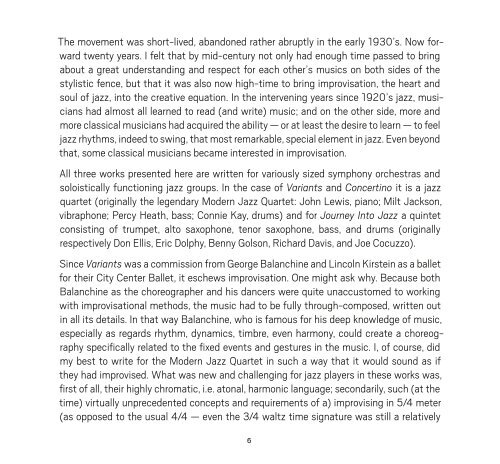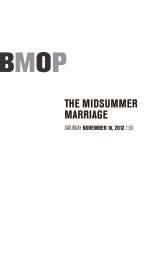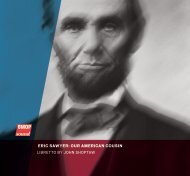gunther schuller: journey into jazz - Boston Modern Orchestra Project
gunther schuller: journey into jazz - Boston Modern Orchestra Project
gunther schuller: journey into jazz - Boston Modern Orchestra Project
Create successful ePaper yourself
Turn your PDF publications into a flip-book with our unique Google optimized e-Paper software.
The movement was short-lived, abandoned rather abruptly in the early 1930’s. now forward<br />
twenty years. i felt that by mid-century not only had enough time passed to bring<br />
about a great understanding and respect for each other’s musics on both sides of the<br />
stylistic fence, but that it was also now high-time to bring improvisation, the heart and<br />
soul of <strong>jazz</strong>, <strong>into</strong> the creative equation. in the intervening years since 1920’s <strong>jazz</strong>, musicians<br />
had almost all learned to read (and write) music; and on the other side, more and<br />
more classical musicians had acquired the ability — or at least the desire to learn — to feel<br />
<strong>jazz</strong> rhythms, indeed to swing, that most remarkable, special element in <strong>jazz</strong>. Even beyond<br />
that, some classical musicians became interested in improvisation.<br />
all three works presented here are written for variously sized symphony orchestras and<br />
soloistically functioning <strong>jazz</strong> groups. in the case of Variants and Concertino it is a <strong>jazz</strong><br />
quartet (originally the legendary <strong>Modern</strong> Jazz quartet: John lewis, piano; Milt Jackson,<br />
vibraphone; Percy Heath, bass; connie Kay, drums) and for Journey Into Jazz a quintet<br />
consisting of trumpet, alto saxophone, tenor saxophone, bass, and drums (originally<br />
respectively Don Ellis, Eric Dolphy, Benny Golson, Richard Davis, and Joe cocuzzo).<br />
Since Variants was a commission from George Balanchine and lincoln Kirstein as a ballet<br />
for their city center Ballet, it eschews improvisation. one might ask why. Because both<br />
Balanchine as the choreographer and his dancers were quite unaccustomed to working<br />
with improvisational methods, the music had to be fully through-composed, written out<br />
in all its details. in that way Balanchine, who is famous for his deep knowledge of music,<br />
especially as regards rhythm, dynamics, timbre, even harmony, could create a choreography<br />
specifically related to the fixed events and gestures in the music. i, of course, did<br />
my best to write for the <strong>Modern</strong> Jazz quartet in such a way that it would sound as if<br />
they had improvised. What was new and challenging for <strong>jazz</strong> players in these works was,<br />
first of all, their highly chromatic, i.e. atonal, harmonic language; secondarily, such (at the<br />
time) virtually unprecedented concepts and requirements of a) improvising in 5/4 meter<br />
(as opposed to the usual 4/4 — even the 3/4 waltz time signature was still a relatively<br />
untried, even disdained, notion); b) improvising over long stretches of time in a continuous,<br />
evenly paced, accelerando; c) more fragmented interpretive, constantly changing types<br />
of continuity; and d) in general, integrating extemporization (thematically, rhythmically,<br />
melodically, stylistically) <strong>into</strong> larger, extended, pre-fixed, multi-movement forms. That the<br />
MJq and the other above mentioned musicians more than met these challenges half a<br />
century ago is now a matter of history. That these challenges have now become, almost<br />
fifty years later, common practice, is brilliantly demonstrated in the herewith recorded<br />
performances.<br />
6 7










